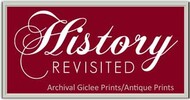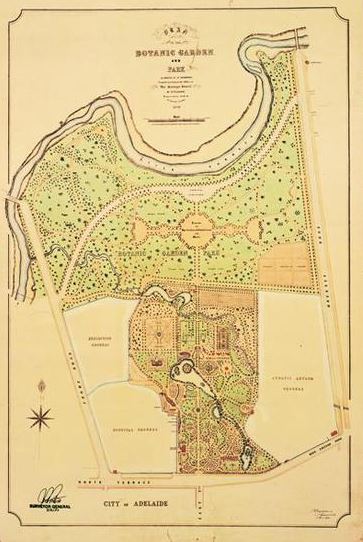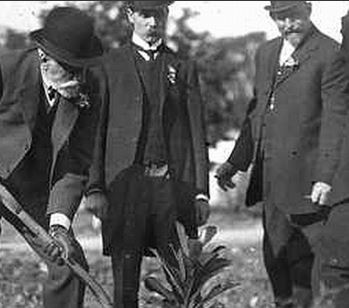 Loading... Please wait...
Loading... Please wait...All prices are in All prices are in AUD
Categories
- Home
- Blog History Revisited
- conservation
Blog History Revisited - conservation
Forest Flora of South Australia : John Edne Brown
Posted by ©Sandra Ker, Antiquarian Print Gallery, Unley, South Australia est. 1989. Antique Print and Map dealer. www.historyrevisted.com.au on 29th Aug 2015
John Ednie Brown (1848-1899) - His Quest
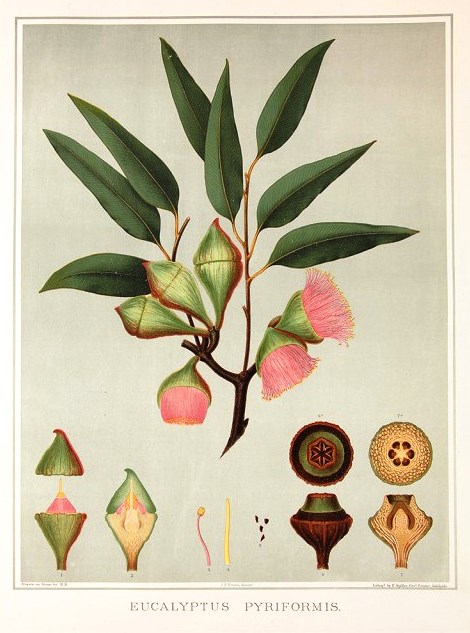 In 1878 an interesting Scotsman, John Ednie Brown, arrived in Adelaide from California, on the request of the South Australia Government. He was to take up the post of Conservator of Forests for the Government of South Australia. Brown had a glowing international reputation as a "Man of Trees" when he entered this, "a slice of London in the Antipodes". Brown was Australia's first silviculturalist, one who understood the botanical, commercial and aesthetic value of this most important of resources. Many of those corseted and topped-hatted colonists were already busy deconstructing the landscape through agricultural, grazing and mining pursuits to achieve the wealth that a free colony promised. The well-travelled Brown, was powerless to halt such energy. However, he would use the artistic talent, technical and educational resources of this colony to document and preserve the colony's botanical distribution for future generations. The end result was the comprehensive documentation of South Australia's native botany produced between 1882-1890, The Forest Flora of South Australia.
In 1878 an interesting Scotsman, John Ednie Brown, arrived in Adelaide from California, on the request of the South Australia Government. He was to take up the post of Conservator of Forests for the Government of South Australia. Brown had a glowing international reputation as a "Man of Trees" when he entered this, "a slice of London in the Antipodes". Brown was Australia's first silviculturalist, one who understood the botanical, commercial and aesthetic value of this most important of resources. Many of those corseted and topped-hatted colonists were already busy deconstructing the landscape through agricultural, grazing and mining pursuits to achieve the wealth that a free colony promised. The well-travelled Brown, was powerless to halt such energy. However, he would use the artistic talent, technical and educational resources of this colony to document and preserve the colony's botanical distribution for future generations. The end result was the comprehensive documentation of South Australia's native botany produced between 1882-1890, The Forest Flora of South Australia.
"Man of Trees"
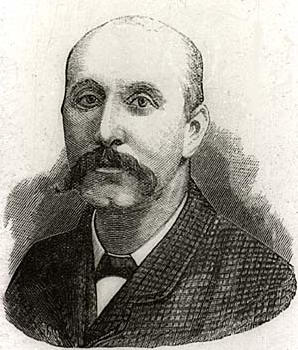
John Ednie Brown had begun his career in 1864 as Nursery and Forest management the Scotland. He then visited the USA in 1871-72. The reports he submitted on the importance of Californian Forests vs agricultural land use, guaranteed his international reputation as a "Man of Trees". Brown recognized South Australia had shared the same development of land as he had witnessed in California: our pastoral reputation had us “riding on the sheep’s back” along with a growing agricultural reputation, earning the title of “Granary of Australia”, by the 1870s. The clearance of flora and habitat had been sudden and comprehensive. There was little he could do to hold back the tide of economic furore, but the colonial infrastructure and skills he required to record the native botany that being swept away was already here. Artists to render anatomical records, a Botanical Garden to store and propagate seeds, Government Printing house, lithographers (from Melbourne) and an eager cohort to purchase his ambitious undertaking. The Forest Flora of South Australia was issued to subscribers as quarterly parts over eight years. The resulting five volume publication remains the largest and most accurate group of botanical illustrations depicting Australian native plants made in the colonial period.
South Australia, British Prototype Free Colony
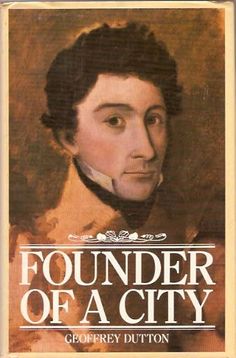
Surveyor General Light had intended the colonists to benefit from an extensive botanical garden to be placed along the River Torrens, reminiscent of Kew Gardens. Finally in 1857 the Gardens were opened to the Public. By 1866 this botanical showcase was 36 hectares in size. During Dr. Richard Schomburgk’s management (1865-1891) of the Gardens, the Museum of Economic Botany was established in the garden precinct to house an extensive collection of seeds, fruits and samples from international sources but also our native species. However, it seems we owe a huge legacy to John Ednie Brown: Colonel William Light may have created the parklands but a 1880 report by Brown, "broke that green space into a series of parkland blocks…examined their soils…identified their potential use and then recommended landscape design and plantings for each one."
Botanical Artist : Rosa Fiveash
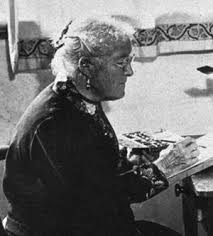
Next-Local lass, Rosa Catherine Fiveash (1855-1938), was born in Adelaide, studied at the Adelaide School of Art on North Terrace and taught herself the art of botanical illustration. Her first major project was for John Ednie Brown. Between 1880-1890 Rosa set about scientifically dissecting & painting the seeds, bark, flowers, for botanical record, while the seeds and dried specimens could be stored by the Botanical Gardens, just like London's Kew Gardens. Brown predicted that in future years the plants could be reintroduced to the areas from which they had been cleared. Councils and garden enthusiasts today can put this information to good use to preserve our rural flora, together with the biodiversity it supports. This was a very progressive concept for an era that believed “rain followed the plough”.
Goyder's Line of Rainfall: The Colonial Dispute
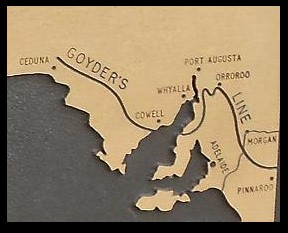
The year 1865 was a bumper year for rainfall. In the same year the Surveyor General, George Woodroofe Goyder, drew a boundary line across South Australia from Ceduna to Pinnaroo. He traversed the landscape taking only two months by observing botanical "red flags". Goyder's Line of Rainfall was to become the boundary believed to be suitable for agriculture. Many ignored his advice that the land was only suitable for grazing and not cropping. The ghost towns and abandoned homesteads are testimony to the harsh evidence of this folly. John Ednie Brown argued against Goyder's findings. Brown was adamant that mass planting of trees north of Quorn would bring rain to these marginal, unproductive lands. On this point the two men clashed both publicly and privately.
Final Step : South Australian Government Printer
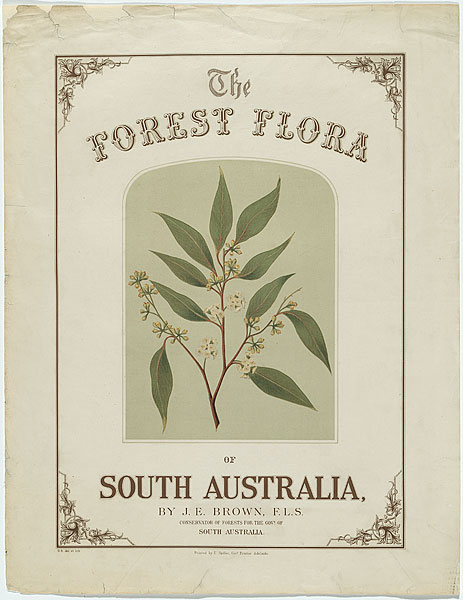 Using the beautifully accurate botanical renderings of Fiveash, and other talent in the colony, a printer for text and images was now required. Located on King William Rd and North Terrace, the Government Printer was just the ticket. The modern technique of chromolithography used coloured inks off Bavarian limestone blocks. It had been developed in the 1860's as a more cost-effective way to produce coloured images instead of hand colouring black and white lithographs & engravings. The collection, consequently, printed in Adelaide between 1882-1890 (even though Melbourne lithographers were imported on a rotation). Each volume consisted of Twelve parts in paper covers as seen right. Each Part contained five chromolithographs accompanied by typeset of species distribution, common names etc. This was a very affordable proposition for subscribers, who purchased each part for five shillings. On the completion of each volume, they could have them bound in leather by local bookbinders. However, it seems many chose to forgo that additional expense or may have passed away before completing their subscription. How else would many of treasured unbound parts have survived. Conservation framing today can preserve these survivors of the past to benefit the future. This comprehensive collection curated by a canny Scot is a legacy that proves past environmental concern.
Using the beautifully accurate botanical renderings of Fiveash, and other talent in the colony, a printer for text and images was now required. Located on King William Rd and North Terrace, the Government Printer was just the ticket. The modern technique of chromolithography used coloured inks off Bavarian limestone blocks. It had been developed in the 1860's as a more cost-effective way to produce coloured images instead of hand colouring black and white lithographs & engravings. The collection, consequently, printed in Adelaide between 1882-1890 (even though Melbourne lithographers were imported on a rotation). Each volume consisted of Twelve parts in paper covers as seen right. Each Part contained five chromolithographs accompanied by typeset of species distribution, common names etc. This was a very affordable proposition for subscribers, who purchased each part for five shillings. On the completion of each volume, they could have them bound in leather by local bookbinders. However, it seems many chose to forgo that additional expense or may have passed away before completing their subscription. How else would many of treasured unbound parts have survived. Conservation framing today can preserve these survivors of the past to benefit the future. This comprehensive collection curated by a canny Scot is a legacy that proves past environmental concern.
School Arbor Days: Another John Edne Brown Legacy
NSW Premier, Sir Henry Parkes, heard of Brown's good works and poached him by offering a more lucrative pay increase. In essence he was "head-hunted" by another Colony. However, before John Edne Brown left the Colony he held the first Australian "Arbor Day" on June 20 1889, an idea imported from the United States. "After a parade of some 5000 Adelaide school children and dignitaries, a parade of the participants from Victoria Square, the governor, Lord Kintore, and his wife, planted a Bunya Bunya (Araucaria bidwillii) and a Weeping Scotch Elm (Ulmus pendula) that grow today."
It was a celebration of trees for a healthy land and the inhabitants that rely upon it.
Fish'n Chips Lesson for the Environmentally Aware Today
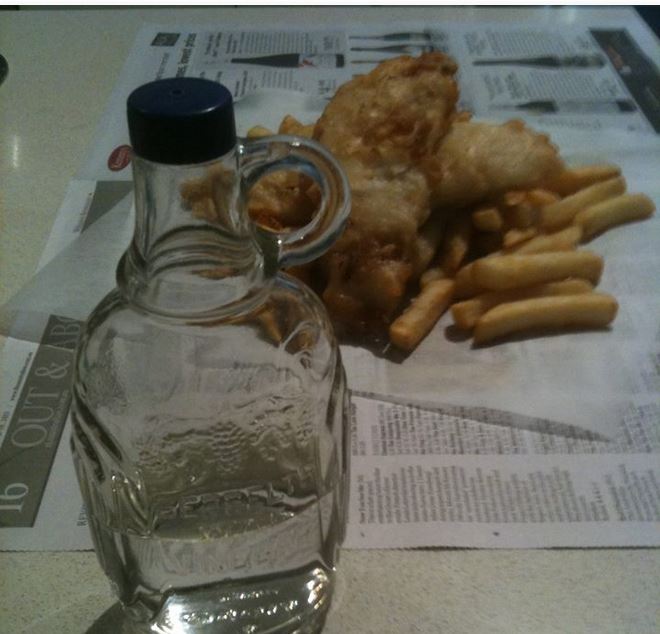
When I first exhibited the antique chromolithographs of "Forest Flora of South Australia", some of my clients retold stories about Fish 'n Chips in floral paper. Now, I remember in my youth, newspaper being a traditional outer wrapping of the ever-popular takeaway beach staple. As Brown's ambitious botanical collection was printed here in Adelaide by a process requiring the overlay of up to five lithographic stones, there must have been "seconds", i.e. those that didn't pass muster. Rather than just throw it away, this "pretty coloured paper" was used to wrap take away food of that era, like delicious, instead of plastic containers.
©Sandra Ker, Antiquarian Print Gallery, South Australia 2015
Recent Posts
- » Lady Sarah Lennox, King George III & The Honourable George Napier
- » Schomburgk's Botanic Garden & Park Plan, 1874
- » "City of Adelaide" Clipper Ship - What is Old Is New Again
- » Napoleon, Hudibrastic Poetry, Doctor Syntax & the Power of Satire
- » Colonial Melbourne to Albury "Parlour Car" Photo Connects to Adelaide Past & Present
